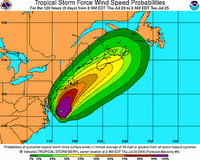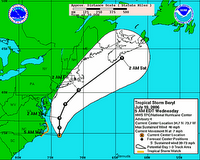Tropical Storm Beryl quietly made landfall on Nantucket early Friday, bringing a steady, driving rain to coastal Massachusetts. Hours later, it moved out to sea, leaving little but a soaking in its path.
The storm's center hit around 3 a.m., said Jack Beven, hurricane specialist with the National Hurricane Center in Miami.
The wind and rain started to pick up just after midnight, said Rocky Fox, owner of the Chicken Box bar there. But he wasn't scared: "It's the kind that puddles quick," he said. "To us it's just a big old Nor'easter."
Officials said the region fared well. The Coast Guard said they hadn't heard of problems, and no power outages were reported.
"It looks like a gray, rainy day," said Nantucket Fire Department Capt. Steve Murphy as he looked out the window.
A tropical storm warning issued from the coast of Massachusetts was discontinued Friday morning, according to the National Hurricane Center in Miami. Areas affected included Cape Cod, Nantucket and Martha's Vineyard.
At 5 a.m. EDT, the storm had maximum sustained winds of about 50 mph, and was about 35 miles northeast of Nantucket. It was expected to weaken over the next 24 hours and lose tropical characteristics by Saturday morning.It was moving at about 21 mph and was expected to increase in speed Friday, forecasters said. The center of Beryl was expected to be near or over Nova Scotia late Friday or early Saturday.
The Coast Guard was monitoring about 50 commercial fishing vessels still on the New England waters near the storm's path late Thursday night, but had no reports of vessels in trouble, said Chief Petty Officer Scott Carr.A tropical storm watch had been issued for eastern Long Island and parts of Connecticut, but was discontinued early Friday as the storm moved northeast.A tropical storm watch had been issued for eastern Long Island and parts of Connecticut, but was discontinued early Friday as the storm moved northeast.
Workers at Nantucket Moorings on Thursday were making sure their customers' boats were tied down securely, but they weren't panicking.
"That's all we can do for now — make sure lines are secure and people know that the storm is approaching," said Leigh Van Hoven, office manager of the company, which rents and sells moorings.
A record 28 named storms and 15 hurricanes, including destructive Katrina, occurred during last year's June-November Atlantic hurricane season.
The first named storm of the 2006 season, Tropical Storm Alberto, swept over Florida in mid-June, then plowed northward along the coast past the Outer Banks. It was blamed for one drowning.


